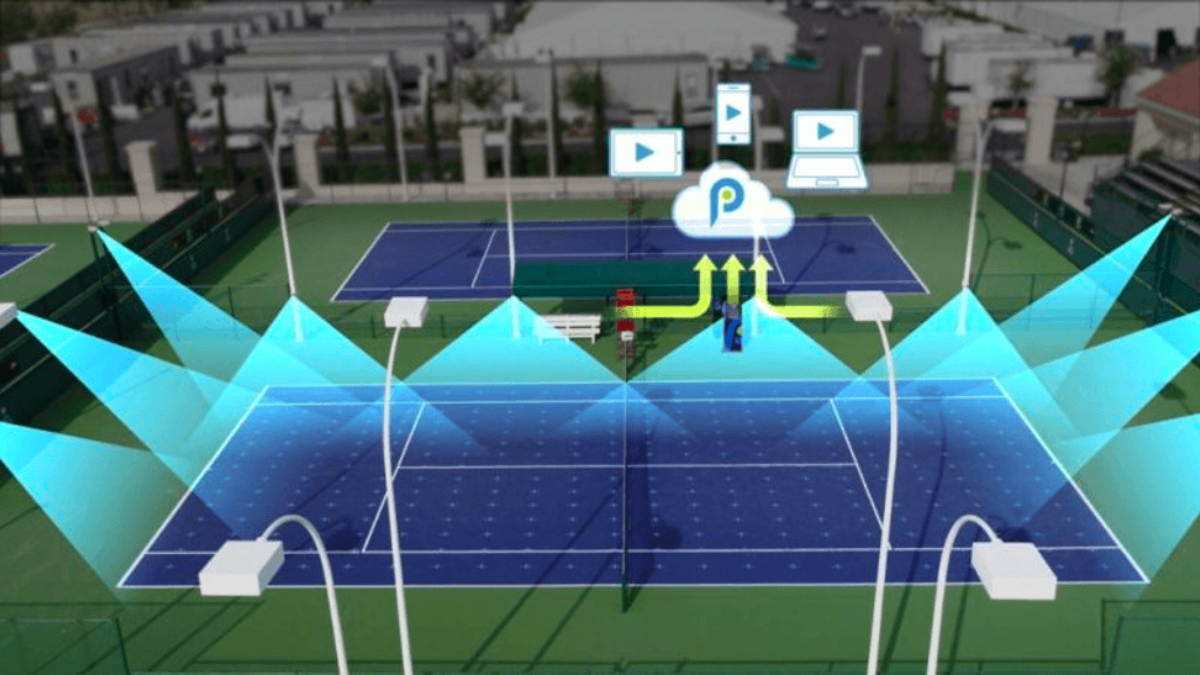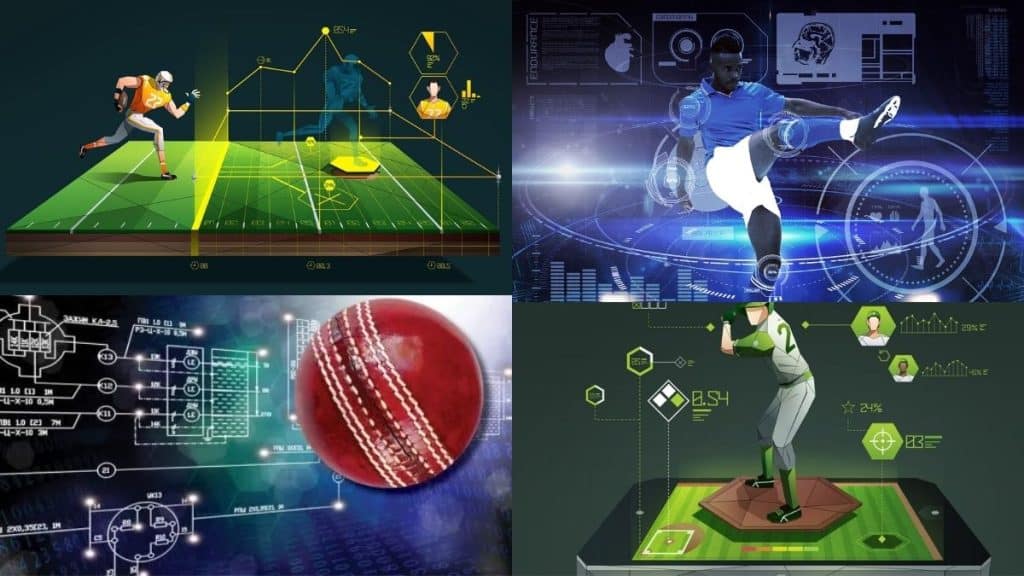Tennis and Technology: A Revolution in the Game
Tennis and technology have intertwined in a captivating dance, transforming the sport from its humble beginnings to the high-tech spectacle we see today. From the evolution of the tennis ball […]

Tennis and technology have intertwined in a captivating dance, transforming the sport from its humble beginnings to the high-tech spectacle we see today. From the evolution of the tennis ball and racquet to the emergence of electronic line calling systems, technology has consistently pushed the boundaries of the game, influencing player performance, fan engagement, and even accessibility.
This journey through the history and future of tennis technology reveals how innovation has not only enhanced the game but also shaped the way we play, train, and experience it. Whether it’s the use of biomechanics analysis to optimize a player’s swing or the use of virtual reality to create immersive training environments, technology continues to redefine the possibilities of this beloved sport.
Tennis Technology Evolution: Tennis And Technology

Tennis, a sport known for its grace and precision, has witnessed a remarkable evolution driven by technological advancements throughout its history. From the humble beginnings of the game to the high-tech era of today, technology has played a pivotal role in shaping the sport’s trajectory, impacting its equipment, playing surfaces, and even the way matches are officiated.
Impact of Technological Advancements on Tennis Equipment
The evolution of tennis equipment has been a continuous process, with each innovation pushing the boundaries of performance and influencing the way the game is played.
- The Tennis Ball: The development of the modern tennis ball, with its consistent size, weight, and bounce, revolutionized the game. Early tennis balls were made from various materials, including leather, wool, and rubber, resulting in inconsistent performance. The invention of the felt-covered rubber ball in the late 19th century provided a more standardized and reliable playing experience, enabling players to hit the ball with greater accuracy and power.
- The Tennis Racquet: The evolution of the tennis racquet has been equally significant. From the wooden racquets of the early days, which were heavy and limited in power, to the modern composite racquets made from materials like graphite, aluminum, and titanium, the racquet has become lighter, more powerful, and more versatile. The introduction of larger racquet heads and the development of string patterns have further enhanced the control and power of players, allowing them to hit the ball with greater precision and speed.
Impact of Technological Advancements on Tennis Surfaces
The surfaces on which tennis is played have also undergone significant transformations, influencing the game’s style and strategy.
- Grass: The original surface of tennis, grass courts offer a fast and low-bouncing surface that favors aggressive play and serves. The natural grass surface, however, is susceptible to weather conditions and requires careful maintenance.
- Clay: Clay courts, with their slower and higher-bouncing surface, provide a more tactical and strategic playing environment. The clay surface allows for longer rallies and encourages players to focus on shot placement and consistency.
- Hard Courts: Hard courts, made from acrylic or concrete, offer a balanced playing surface, combining the speed of grass with the tactical demands of clay. Hard courts are also more durable and require less maintenance than grass or clay courts.
Impact of Electronic Line Calling Systems on Tennis
The introduction of electronic line calling systems has significantly changed the way tennis matches are officiated. Before the advent of these systems, line calls were made by human umpires, who were prone to errors. This often led to controversies and disputes, which could affect the outcome of matches.
- Hawk-Eye: Hawk-Eye, a computer-based system that uses multiple cameras to track the ball’s trajectory, has become a standard feature in professional tennis. The system provides an instant and accurate replay of the ball’s path, allowing umpires to make definitive line calls.
- Impact on the Game: The introduction of electronic line calling systems has significantly reduced the incidence of disputed line calls, leading to a fairer and more efficient game. Players now have greater confidence in the accuracy of line calls, allowing them to focus on their game without worrying about potential officiating errors.
Technology’s Impact on Player Performance
The integration of technology into tennis has revolutionized the way players train and compete. From analyzing biomechanics to tracking fitness data, technology has provided players with powerful tools to enhance their performance and develop new strategies.
Biomechanics Analysis
Biomechanics analysis plays a crucial role in understanding and optimizing player movements. Advanced motion capture systems and software programs allow coaches to meticulously analyze every aspect of a player’s swing, footwork, and overall movement patterns. This detailed analysis reveals key insights into areas for improvement, such as swing mechanics, balance, and efficiency.
- Coaches can identify subtle inconsistencies in a player’s swing, such as variations in racquet head speed or grip pressure, that might be hindering performance.
- By visualizing a player’s movement in 3D space, coaches can pinpoint specific areas where adjustments are needed to improve efficiency and power.
- Biomechanics analysis also helps coaches tailor training programs to individual players’ strengths and weaknesses, ensuring that training is targeted and effective.
Video Analysis
Video analysis has become an indispensable tool for tennis players and coaches. High-definition cameras capture every shot from multiple angles, allowing for detailed analysis of technique, strategy, and opponent tendencies.
- Players can review their own matches and practice sessions to identify areas for improvement, such as shot selection, court positioning, and tactical decision-making.
- Coaches can use video analysis to break down opponent strategies, identify weaknesses, and develop countermeasures.
- Advanced video analysis software enables the tracking of ball trajectories, player movement, and other key metrics, providing valuable data for performance optimization.
Fitness Tracking Devices
Wearable fitness trackers and smartwatches have become commonplace in tennis training. These devices monitor heart rate, sleep patterns, and other physiological data, providing valuable insights into a player’s physical condition.
- Players can track their training intensity, recovery time, and overall fitness levels, ensuring that they are training effectively and avoiding overtraining.
- Coaches can use this data to tailor training programs to individual players’ needs and optimize their physical preparation for competitions.
- Fitness trackers also provide real-time feedback during training sessions, allowing players to adjust their effort levels and maintain optimal performance.
Impact on Player Performance
The adoption of these technologies has had a profound impact on player performance in tennis.
- Players are now able to train more effectively, focusing on specific areas for improvement and optimizing their physical condition.
- The use of biomechanics analysis and video analysis has led to the development of more efficient and powerful swing techniques, as well as improved court coverage and tactical awareness.
- The emergence of new technologies has also contributed to the development of new playing styles, with players pushing the boundaries of what is possible on the court.
Technology in Tennis Broadcasting and Fan Engagement
Technology has revolutionized the way tennis is broadcast and consumed by fans, enhancing the viewing experience and fostering deeper engagement with the sport. From high-definition cameras capturing every shot to interactive platforms connecting fans worldwide, technology has played a crucial role in transforming tennis broadcasting.
Impact of Technology on the Viewing Experience
Technological advancements have significantly enhanced the viewing experience for tennis fans. High-definition cameras capture every detail of the action, allowing viewers to feel like they are courtside. Slow-motion replays provide a detailed analysis of each shot, showcasing the intricate techniques and strategies employed by players. Real-time data visualizations, such as speed readings, serve placement, and court coverage, offer viewers valuable insights into the match’s dynamics.
Fan Engagement through Technology
Technology has facilitated unprecedented fan engagement in tennis. Interactive platforms, such as live chat rooms and social media feeds, allow fans to connect with each other and share their opinions and reactions during matches. Online streaming services provide fans with convenient access to live and on-demand content, breaking down geographical barriers and expanding the reach of the sport.
“Technology has made tennis more accessible and engaging for fans than ever before. With high-definition cameras, slow-motion replays, and real-time data visualizations, viewers can experience the sport in a way that was previously unimaginable. Interactive platforms and online streaming services have further connected fans worldwide, fostering a global community of tennis enthusiasts.”
The Future of Tennis Technology
Tennis, a sport steeped in tradition, is embracing the transformative power of technology at an unprecedented pace. From enhancing player performance to revolutionizing fan engagement, technology is shaping the future of the game. This section explores potential advancements in wearable technology, artificial intelligence, and virtual reality, and their impact on the game, players, fans, and the industry.
Wearable Technology
Wearable technology is poised to play a pivotal role in the future of tennis, offering players, coaches, and fans valuable insights and real-time data.
- Advanced Biometric Monitoring: Wearable devices will become more sophisticated, offering comprehensive data on player performance, including heart rate, oxygen levels, and muscle fatigue. This information can be used by coaches to optimize training regimens, prevent injuries, and improve player recovery. For instance, players like Naomi Osaka and Rafael Nadal have already incorporated heart rate monitors into their training routines, demonstrating the value of biometric data.
- Real-Time Performance Analysis: Wearables will integrate with AI algorithms to provide real-time performance analysis during matches. This data can help players identify weaknesses, adjust their game plan, and make better decisions on the court. The technology could also provide insights into player movement patterns, serve speed, and shot accuracy, giving coaches valuable feedback for improvement.
- Personalized Training Plans: By collecting data on player performance, wearables can contribute to the creation of personalized training plans tailored to individual needs. This can help players optimize their development, reduce the risk of injury, and achieve peak performance.
Artificial Intelligence
AI is revolutionizing various aspects of tennis, from player training and match analysis to fan engagement and broadcasting.
- AI-Powered Coaching: AI-driven coaching systems can analyze player performance data, identify areas for improvement, and recommend specific drills and exercises. These systems can provide personalized feedback and guidance, helping players improve their skills and optimize their game.
- Enhanced Match Analysis: AI can analyze match data, including shot patterns, court positioning, and player movement, to provide detailed insights into player performance. This data can be used by coaches to develop strategies, identify weaknesses, and predict opponent behavior.
- Automated Officiating: AI could potentially automate certain aspects of officiating, such as line calling and fault detection. This could enhance the accuracy and efficiency of officiating, reducing the potential for human error and controversy.
Virtual Reality
VR technology is emerging as a powerful tool for training, simulation, and fan engagement in tennis.
- Immersive Training Environments: VR can create realistic simulations of tennis matches, allowing players to practice against virtual opponents in various conditions. This can help players improve their reflexes, decision-making, and mental focus.
- Enhanced Fan Experiences: VR can provide fans with immersive experiences, allowing them to feel like they are on the court with their favorite players. This could involve watching matches from different perspectives, experiencing the thrill of playing a point, or interacting with players in virtual settings.
- Interactive Coaching Tools: VR can be used to create interactive coaching tools, allowing players to receive personalized instruction and feedback in a virtual environment. This can be particularly helpful for players who are unable to access traditional coaching resources.
Tennis Technology and Accessibility

Technology has played a significant role in making tennis more accessible to players of all abilities, breaking down barriers and fostering a more inclusive environment. This accessibility has expanded participation opportunities, making the sport more enjoyable and rewarding for a wider range of individuals.
Adaptive Equipment
Adaptive equipment has been instrumental in enabling individuals with disabilities to participate in tennis. These modifications cater to specific needs and allow players to overcome physical limitations, ensuring a level playing field.
- Wheelchairs: Custom-designed wheelchairs with specialized features like larger wheels and lightweight frames provide stability and maneuverability on the court. These adaptations allow wheelchair tennis players to move swiftly and efficiently, executing shots with precision.
- Adaptive Racquets: Racquets with modified grips and weights cater to players with limited hand strength or dexterity. These adjustments enhance grip stability and control, allowing players to generate power and accuracy in their shots.
- Prosthetics: Advancements in prosthetic technology have enabled players with limb differences to compete at high levels. Prosthetics with improved biomechanics and responsiveness provide greater control and stability, allowing players to perform complex movements and techniques.
Virtual Coaching and Online Learning Platforms, Tennis and technology
Virtual coaching and online learning platforms have democratized access to high-quality tennis instruction, bridging the geographical gap between players and coaches. These technologies provide personalized feedback and guidance, enhancing skill development and improving performance.
- Online Video Analysis: Players can record their practice sessions and analyze their technique through online video analysis tools. These platforms offer detailed insights into their stroke mechanics, footwork, and overall game strategy, facilitating self-improvement and performance optimization.
- Interactive Training Apps: Interactive training apps provide personalized drills and exercises tailored to individual skill levels and goals. These apps offer gamified learning experiences, making practice more engaging and effective, while providing real-time feedback and progress tracking.
- Remote Coaching Sessions: Virtual coaching sessions allow players to connect with qualified coaches remotely, receiving personalized instruction and guidance. This eliminates the need for physical proximity and provides access to expert coaching for players in remote areas or with limited mobility.
The Ethics of Technology in Tennis
The rapid integration of technology into tennis has sparked debates about its ethical implications. While technology has undeniably improved the game’s efficiency and entertainment value, concerns regarding its potential impact on the sport’s integrity and fairness are increasingly prevalent. This section delves into the ethical dilemmas surrounding the use of technology in tennis, examining its influence on the game’s core principles.
Technology’s Impact on the Integrity of the Game
The use of technology in tennis has raised questions about the sport’s integrity, particularly concerning performance-enhancing devices and data manipulation. The possibility of players using technology to gain an unfair advantage has become a significant ethical concern.
- Performance-Enhancing Devices: The advent of wearable technology has raised concerns about the potential for athletes to use devices that provide real-time feedback on their performance, such as heart rate monitors, GPS trackers, and biofeedback sensors. These devices could potentially be used to enhance performance by optimizing training regimens, identifying weaknesses, and providing insights into an opponent’s strategies. However, the ethical implications of such technology are debatable, as some argue that it merely enhances training and preparation, while others view it as a form of cheating.
- Data Manipulation: The use of data analytics in tennis has also raised concerns about the potential for data manipulation. Players and coaches could potentially manipulate data to gain an unfair advantage, such as altering statistics or creating false narratives to influence opponents or officials. The ethical implications of data manipulation are significant, as it undermines the integrity of the game and erodes trust in the sport’s results.
Technology’s Influence on Player Decisions and Match Outcomes
The use of technology in tennis has also raised questions about its potential to influence player decisions and manipulate match outcomes. The introduction of technologies like Hawk-Eye and electronic line calling has provided players with more information and potentially shifted the dynamics of the game.
- Challenging Calls: The ability to challenge line calls using Hawk-Eye has given players more control over the outcome of points, potentially influencing their decision-making and strategies. Players may become more hesitant to play aggressively, knowing they can challenge a close call. This can lead to more conservative play and potentially alter the game’s flow and excitement.
- Real-Time Data and Insights: The availability of real-time data and insights through wearable technology and analytics could influence players’ decision-making during matches. Players may use this information to adjust their tactics, target specific weaknesses in their opponents, or exploit vulnerabilities based on real-time performance data. While this could enhance the strategic aspect of the game, it also raises ethical concerns about the potential for manipulating the outcome of matches through data-driven decision-making.
Closing Notes

As we look ahead, the future of tennis technology promises even more exciting advancements. Wearable technology, artificial intelligence, and virtual reality are poised to revolutionize the game, impacting player performance, fan engagement, and even the accessibility of tennis for players of all levels. The question is not whether technology will continue to shape tennis, but rather how it will continue to evolve and redefine our understanding of this dynamic sport.
Tennis has evolved with technology, from using data analysis to optimize training to incorporating AI-powered coaching apps. This constant evolution reflects the same spirit seen in other industries, like manufacturing, where companies like Meriam Process Technologies are pushing boundaries with innovative solutions.
Just as tennis players rely on precision and strategy, Meriam Process Technologies helps businesses achieve optimal performance through their expertise in automation and process optimization.







